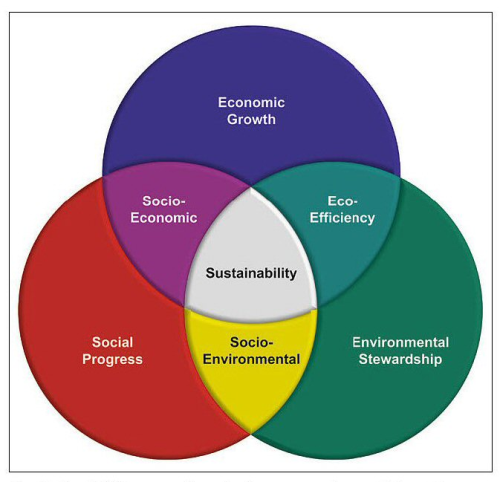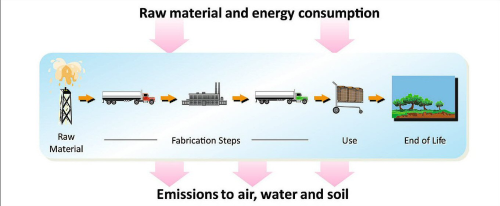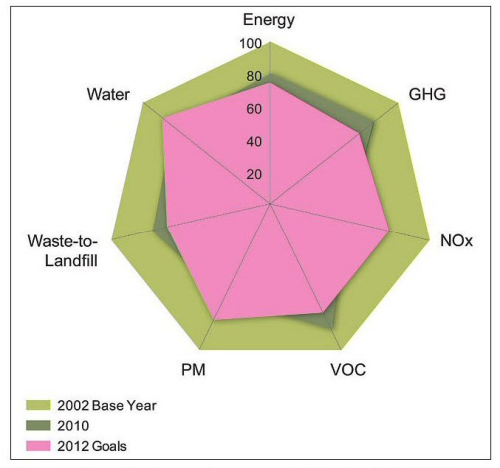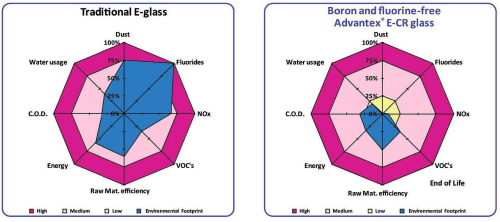



If your customers are like ours, they are asking more questions than ever about the impact of products and manufacturing processes on the environment. Many are familiar with the attributes and environmental impact of materials like wood, steel and aluminium, while there is less knowledge about products made from composite materials. It’s our job to help them understand where composite materials belong in the sustainability conversation.
Sustainability requires balance and consideration of economic, human and environmental factors in order to meet our needs today without compromising the resources available for future generations. The place where all three come together is where green becomes golden.
When that happens, there is potential for companies to operate for profit and advance global economic growth, environmental stewardship and social progress. For example, lowering energy consumption and emissions from operations results in economic benefit through lower operation costs and improved quality of life for a community, a nation or a world.
Benefits of composites
Composite materials are used in more than 40 000 end-use applications in many large markets like transportation, power and energy. Macro trends driving more sustainable practices include energy use and availability, the effects of climate change and the ever-rising population and consumption of resources. There is a need for scalable solutions that address these challenges, and composites can be the answer in a world where demand for sustainable solutions continues to grow.
Technology and innovation are critical to our commitment to reduce our global footprint. It is equally important when we develop products.
“Looking to the future, the transportation industry is particularly ripe for continued innovation, says Arnaud Genis, Owens Corning Composite Solutions Business president. “There is a lot of work taking place to produce energy-efficient and more eco-friendly vehicles and to reduce CO2 emissions.”
Weight reduction is a major factor which can improve energy efficiency and produce more eco-friendly vehicles that emit less CO2. Additionally, as producers of electric cars add heavier batteries to power these vehicles, other components of the car have to become lighter.
Demand for composite materials continues to rise because composites can be more economical, durable and lighter weight than traditional materials. They align well with the global trends of sustainability, energy efficiency and water preservation.
For example, composites’ light weight, high strength, cost and design flexibility provides a logical choice for longer wind turbine blades which produce more kilowatts (kW) per turbine. In environments where there is exposure to chemicals or saltwater, the corrosion resistance of composite materials prolongs the life of the end-use product and reduces risk of failure. Composite parts have superior strength to weight versus steel, and the energy used to manufacture steel or aluminium parts, even with recycling, can exceed the amount used to produce the same part with composite materials.
The properties composites offer enable manufacturers to build sustainable attributes into projects or products that may increase energy efficiency, durability and the use of materials that lower environmental impact. The increasing demand for renewable energy, fuel-conserving transportation and greener buildings open a world of opportunity in the composites industry.
Life cycle assessment (LCA)
The method used to assess or compare the environmental impact of the materials used to produce a particular component is a life cycle assessment, or LCA. The LCA measures environmental impacts for a number of different attributes rather than comparing a single attribute like recycled contents. A life cycle assessment considers the raw material production, product manufacturing, distribution, use phase, disposal phase and the impact of transportation. This begins with harvesting and extracting materials to make the product until its ultimate disposal.
The simple graphic on the right represents a pictorial of product lifecycle from ‘cradle to grave.’
Some of the common categories one should consider in a comprehensive LCA include:
- energy consumed, both renewable and non-renewable;
- global warming, greenhouse gases;
- acidification, soil and water;
- smog production;
- ozone depletion;
- excess nutrients to water bodies;
- eco- and human toxicology; and
- depletion of minerals and fossil fuels.
The quantitative values come from the assessment of energy and environmental inputs and outputs. LCA results can be expressed in different ways. When examining the manufacture of raw materials, the LCA impact may be represented by the kilogram impact per unit produced. If the study focuses on a total assembly or component, it describes the functional unit of, and relative materials used for, that assembly or component.
LCA quantitative results provide a valuable tool for designing products and enabling product developers to optimise the environmental performance of the end product. Many companies use the stages of the life cycle to manage and continuously improve environmental impact. LCA results also can be used as a way to provide comparisons of the material alternatives which may be used for a product. In the near future, environmental product declaration (EPD) labels that list the value of the environmental impact may be part of product information.
Owens Corning has performed LCAs or used LCA screening techniques on more than 30 product applications over the past five years. The company has performed multiple assessments for several specific composite applications including glass fibre reinforced concrete and infrastructure components such as composite platforms. These assessments have helped customers address product sustainability and demonstrate the benefits of composite materials compared to other material systems.
Customers, specifiers and consumers want to know that the companies they do business with have a commitment to sustainability beyond the products they manufacture. Owens Corning developed a three-part strategy for sustainability:
- greening our operations;
- greening our products; and
- accelerating energy efficiency and renewable energy in buildings and homes.
Owens Corning examined its processes to determine how to reduce its global footprint and green its operations. Ten-year goals were set in 2002 to reduce resources or emissions in seven key areas. The company focused on energy, greenhouse gases (GHG), nitrogen oxide (NOx), volatile organic compounds (VOC), particulate matter (as defined and reported according to regional and government requirements), waste-to-landfill and water.
At the end of 2010, Owens Corning had met three of the seven goals, and is on track to achieve six of the seven by 2012. The seventh goal is focused on reducing VOCs, which has improved by 14% since 2002, and will further benefit from innovation and greening of our insulation and other building materials.
Looking to the future, Owens Corning has set new goals for reducing its global footprint even further by 2020. These goals will target reductions in energy use, greenhouse gas emissions, water usage, toxic air emissions, particulate matter emissions and waste-to-landfill reduction. There will also be focus on addressing supplier sustainability to refine the LCA analysis even further.
Owens Corning’s patented Advantex® glass is boron and fluorine free and has less impact on the environment than traditional E-glass. The manufacturing footprint of Advantex glass compared to traditional E-glass technology offers:
The glass offers high strength, light weight, corrosion resistance, low electrical and thermal conductivity while delivering durability, design flexibility, lower maintenance, reduced down time and lower installation costs. Some typical end-use markets include renewable energy, marine, automotive and building infrastructure. |
These new goals reflect the company’s continued commitment to sustainability and its holistic approach to greening our operations and products. We will partner with customers and suppliers to deliver sustainable solutions in all the markets we serve. Businesses in the composites industry are in a position to offer more sustainable solutions and build a competitive advantage over traditional materials.
“Tools like LCA are going to become more widely used as companies strive to reduce the impact that their processes and products have on the environment,” says Genis. “We expect customers to continue to challenge us to develop sustainable solutions using composite materials.” ♦
This feature was published in the November/December 2011 issue of Reinforced Plastics magazine. To apply to receive your free copy of each issue of Reinforced Plastics please complete the subscription form.




